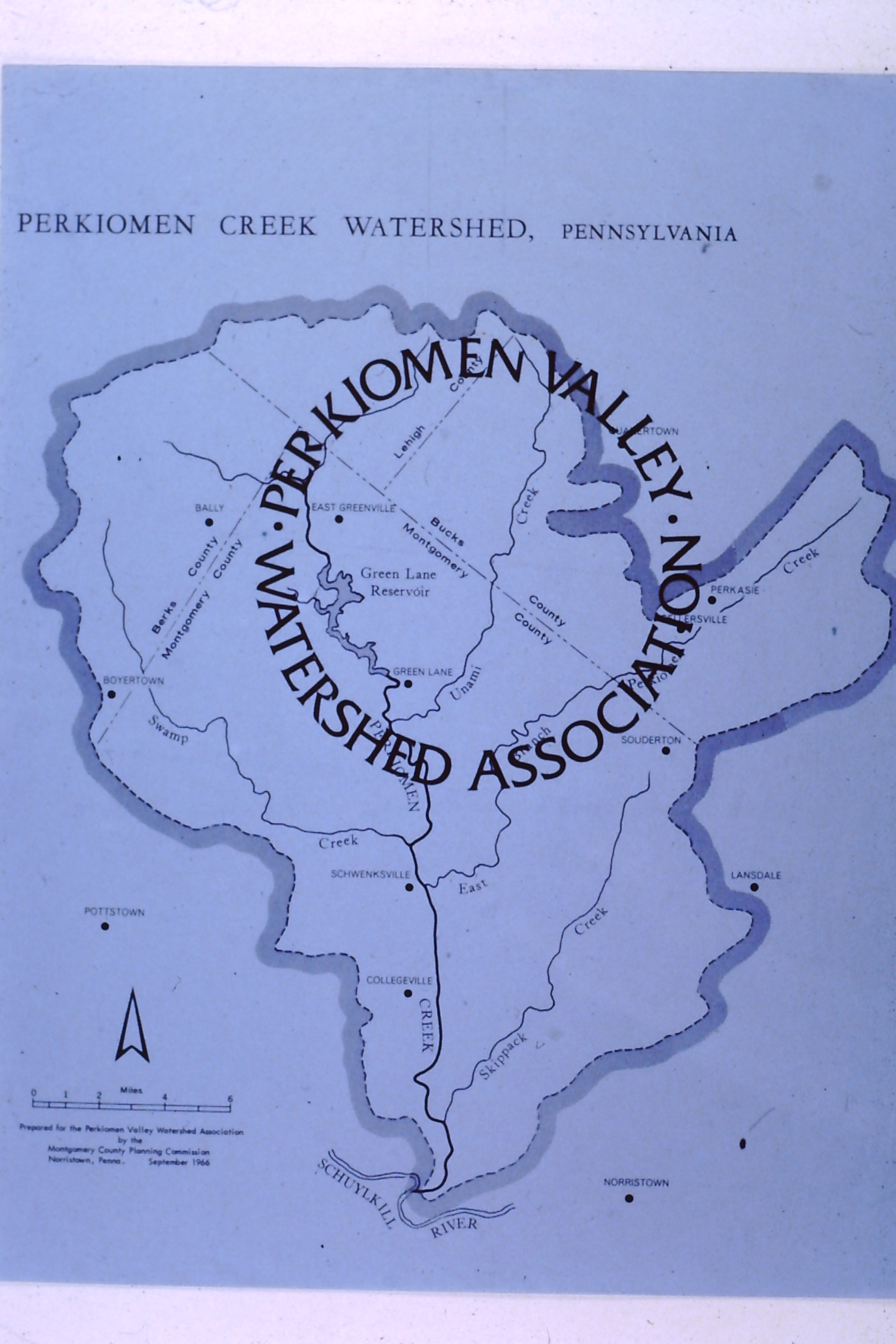Our Beginning
Nature formed the Perkiomen Watershed, a geographic unit of land complete with its own drainage system of surface streams. For centuries the watershed welcomed its human inhabitants, tolerated our changes in lifestyle and the industrial and commercial development associated with the changes. However, danger signs in the form of destructive storms, too much rainfall, or too little, are sent from time to time as reminders of who is really boss over individual ownership and municipal boundaries.
A stop sign in the form of a record drought (1962-1966) warned an increased population that we were stressing the soil-related and water resources of the watershed. Groundwater levels lowered. Some streams went dry. What remained of the surface water system could not assimilate and carry away an overload of agricultural, industrial and community pollutants.
The Perkiomen Watershed Conservancy (PWC), originally the Perkiomen Valley Watershed Association, was organized in 1964 to help address these poor water conditions in the Perkiomen Creek watershed. Early involvement was divided between public education activities, continuing data collection, efforts to advance the idea of state water quality standards and a required degree of treatment for wastes discharged to streams.
In the 50 years since those first meetings, the PWC has helped clean up tons of trash from area creeks, has helped in the preservation of Spring Mountain, has helped educate thousands of children and adults about the natural world and our connection to nature and has helped preserve and repair riparian areas along local creeks to help reduce erosion and improve water quality
Timeline:
1964:
November 23 - Perkiomen Valley Watershed Association (PVWA) came into being as a group of concerned citizens who desired to protect the watershed environment. The incorporating signers functioned as a Board of Directors until the membership could vote a full board to strength. Monthly meetings were held. The incorporating signers included George Dunkle, Frederick Dubbs, Ronald Eastwood, Xenil Felton, William Johnston, Ernest Kruger, Edwin Owens and A.W. Zell with Barbara Paul volunteering as Executive Director.
1965:
Headquarters space was provided in Schwenksville Borough Hall courtesy of Schwenksville Borough Council.
Established individual, group and municipal categories of membership.
First annual meeting to elect Board of Directors featured a guest speaker on the subject of how to preserve open space.
1966:
Board authorized individuals and committees to focus on Clean Streams and Education Programs.
Hired first employee, Mary Jo Weirman, as secretarial assistant.
Obtained grants, signed contracts with the PA Dept. of Health and Lehigh University Institute of Research for a biological and chemical analysis of watershed streams.
Held public informational meetings.
Inventoried 53 dam sites in the watershed in varying stages of ownership.
1967:
PVWA and three member groups testify at public hearings to establish standards and criteria that will improve water quality in watershed streams.
Initiated school and scouts clean-up projects.
Sponsored a Water Pollution Forum at Ursinus College.
1968:
Received approval for the USGS to determine areas of flooding along the Perkiomen Creek from Green Lane to the Schuylkill River.
Open Space Committee held canoe floats on the Perkiomen Creek to determine potential for a hiking trail and greenbelt.
Developed a recreational analysis of the watershed.
Sweet Gum trees donated for Arbor Day planting at schools and public buildings.
Continued Cleanup Campaign and Youth Projects.
1969:
Regional Vice-Presidents held meeting in their various areas to determine pollution problems and issues in the sub-watersheds.
Public information meeting on the Nuclear Generating Plant proposed in Limerick.
Open Space Committee developed a short movie, “Perkiomen Greenbelt Hiking and Canoeing Potential”.
Initiated Conservation Merit Award program, awards to be presented at Annual Meetings.
1970:
First year for “Earth Week” speakers and activities.
1971:
Hired an Executive Director to work in liaison with other agencies on matters of environmental concern and to implement volunteer based programs.
Headquarters moved to the Old Power House Auditorium in Collegeville, courtesy of Erv Shainline.
1972 - 1975:
Celebrated the return of clean streams with the first annual Canoe Day and Races.
Three year wild flora study at Sunrise Mill Park.
Petitioned to intervene before the State Environmental Quality Board in regard to a proposed treatment plant on Unami Creek.
Compiled information on waterways as candidates for inclusion in the PA Scenic River Systems.
Initiated PVWAs Rainfall Reporters Network for precipitation forecasting.
Hired an Assistant to the Executive Director.
Headquarters moved to a rental property at 700 Main Street, Schwenksville.
1976:
Hired an Education Director and increased Environmental Education Programs.
Headquarters moved to Cedar Lane in Collegeville courtesy of Evansburg State Park.
1982 - 1985:
Celebrated the start of the “Botany Section” August 1982
Offered informational programs on local issues of concern on acid rain, TCE contamination, Gypsy Moth controls, disposal of hazardous wastes, needs for recycling, deteriorating in-channel dams in watershed streams and more.
Held meetings on water quality management alternatives for each of the sub watersheds.
Continued to take calls on "Pollution Hotline", conduct stream testing, and advocate open space preservation.
Initiated "Help Us to Help the Bluebirds Project" and annual bird seed sale day.
Expanded annual awards program to recognize government and industry for outstanding conservation or pollution control measures.
Headquarters moved to Level Road, Collegeville courtesy of the Lower Providence Township
Initiated Creek Awareness Sign Project (CASP)
Start of “know your watershed” hikes, canoe trips and streamside walks.
Board of Directors set a priority goal to purchase a permanent headquarters property in the central area of the watershed. Established a building fund for the “acquisition and maintenance of land and a building or buildings to further the objective of the PVWA”
1986:
Headquarters moved to a rental property at the 4H Center in Creamery.
Board of Directors negotiated purchase of brownstone barn on 1.7 acres and began renovations - added stairs and a deck to the front, established landscaping, driveway and parking.
1987:
October 20th - Official Opening and Dedication of the new headquarters at Rt. 73 and Haldeman Road, Schwenksville.
1988 - 1989:
Established Cross Currents Newsletter.
Held public information meetings, field trips and provided data to lead agencies to ensure concerns were incorporated into permit conditions and measures implemented to protect environmental values.
1990:
Established and Education Department and cadre of volunteers.
Held first Halloween Night Hike.
Received a special recognition award from the PA DER for converting the lower level of the Brownstone Barn into a children’s environmental education area.
Built an upper level dormer for office space for staff.
1993:
Held first Lenape Survival Challenge.
1992- 1997:
Initiated Community Environmental Watch (CEW) to advocate for responsible development in the watershed.
Received a special citation from the PA House of Representatives for thirty years of service to the community.
Presented testimony on behalf of upgrading Unami Creek to exceptional value status.
Spoke at hearing on Senate Bill 1157 in support of adding changes to the Municipalities Planning Code which would recognize the importance of environmental features not previously delineated in the Code.
Published the report. "Municipal Watershed Protection: A Case for Local Responsibility and Action" to encourage environmental planning and protection by municipalities in the watershed.
Created an Advisory Board to advise on organizational and environmental issues.
Submitted testimony to DEP on the ramifications of allowing a proposed infectious and chemotherapeutic wastes autoclave to be operated in New Hanover Township and advocated denial of a permit.
1999:
Board of Directors elected to legally change the name of the organization to Perkiomen Watershed Conservancy (PWC) which they felt would better represent the mission.










